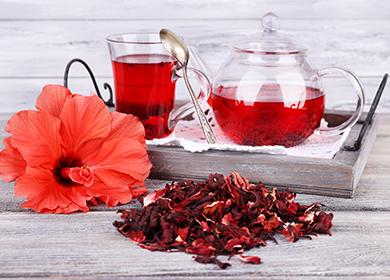The content of the article
Hibiscus - a drink from the flowers of the hibiscus plant. It grows widely in the East Asian region, where it is highly regarded as a decorative and food culture. In Malaysia, the plant is one of the state symbols, it can be seen on local coins. And in Sudan, India, Sri Lanka and Thailand, it is grown on an industrial scale.
Hibiscus Features
Hibiscus blooms with luxurious, richly red flowers, for which he was nicknamed the "Sudanese rose." Although he has nothing to do with the rose family. This is an annual grassy culture of the Malvov family, spiny, absolutely unpretentious, resistant to arid and hot climates.
The first information about its cultivation relates to the history of Ancient Egypt. Traces of flowers were discovered during excavations of the tombs of the pharaohs, which indicates the veneration of the plant and its use in ritual ceremonies. A drink from hibiscus leaves was widely consumed by the inhabitants of ancient Egypt. But the name "drink of the pharaohs" is not connected at all with the fact that it was not available to ordinary people. But rather with the fact that the Egyptians considered him a remedy for most ailments and a gift from the gods.
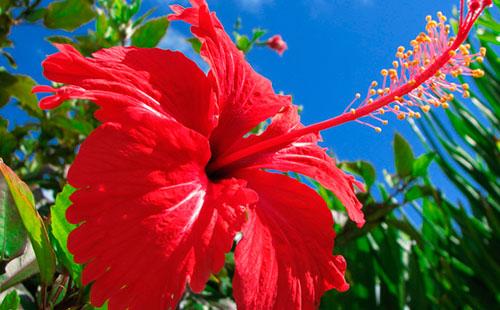
Hibiscus composition
The ancient Egyptians were not far from the truth. The composition of the leaves and flower baskets used to make the hibiscus contains many valuable ingredients.
- Anthocyanins. Derivatives of flavanoids with P-vitamin activity. In the human body, they participate in the formation of vascular cells and tissues, therefore, they improve the structure of blood vessels, reduce their fragility and permeability. Anthocyanins have antioxidant and anti-cancer effects.
- Trace elements. The plant is rich in potassium, necessary to maintain the functioning of the heart muscle. In combination with anthocyanins, potassium provides a full regulatory effect on the cardiovascular system.
- Fruit acids. The petals contain ascorbic and citric acids, which give the drink a characteristic acidity. By the content of ascorbic acid, Sudanese rose is not a record holder, for one hundred grams of the product in the dried state, about one hundred and forty milligrams of vitamin C is stored. Nevertheless, the combination of several types of fruit acids, albeit not in the highest possible concentration, makes the drink a valuable dietary product, as it has a general tonic effect on the body.
Most of the components of the petals are soluble, however, after brewing in the pulp of the leaves, valuable pectins are preserved. These substances regulate the intestines and are able to cleanse it of toxins. Therefore, after drinking the drink, nutritionists advise eating leafs of "tea leaves" too.
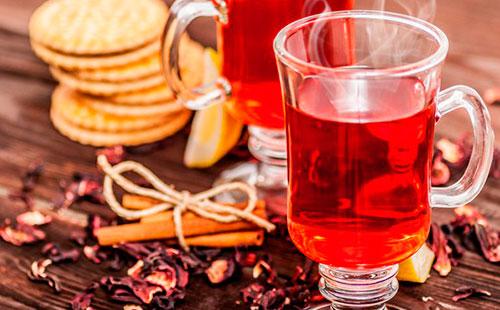
The properties
So, what is carcade tea good for and what effect does it have on the body? Active components act in several directions.
- Antioxidant. It is provided with a high content of anthocyanins. This property is considered the main valuable quality of the drink. Hibiscus antioxidants are water-soluble, it is they who stain tea in such a rich ruby color. Features of the effects of Sudanese rose antioxidants were studied by specialists of the Belgorod National Research University in 2013.It has been established that a high concentration of antioxidants has an overwhelming effect on free radicals that initiate the formation of cancer cells. In terms of the level of anthocyanins, the plant is ahead of all known cultures. In comparison with it, black and green tea are lost, in which there are no antioxidant anthocyanins at all. Experts from Belgorod University have suggested that it is possible to use Hibiscus drink in the diet to achieve the effect of the “French paradox”.
- Anti-inflammatory. The drink has a moderate anti-inflammatory effect and mild diuretic activity. It can be used as an adjunct in the treatment of diseases of the genitourinary system, for disinfection of the urinary tract. It alleviates the condition for colds, provides a diaphoretic effect, reduces the manifestations of fever. In an experiment in mice, Russian experts confirmed an expectorant effect comparable to the action of the drug Mukaltin.
- Stimulates metabolism. Nutritionists recommend including a drink in a weight loss program. Hibiscus improves metabolic processes in the body, stimulates the production of bile, so that digestion of food is faster. An increased metabolism contributes to the breakdown of fats, therefore, a ruby-red drink with an appropriate diet and physical activity can stimulate the loss of excess weight.
- Cleanses and strengthens blood vessels. According to dietitian Lyudmila Denisenko, hibiscus is an indispensable drink for people suffering from diseases of the cardiovascular system. It cleanses blood vessels of cholesterol, preventing the formation of cholesterol plaques and blockage of blood vessels. With regular use, dilates blood vessels and lowers blood pressure.
Hibiscus tea increases or decreases blood pressure? Should you drink it: hot or cold? This question was answered by American scientists who conducted a study of the effect of the drink on the work of the heart and blood vessels.
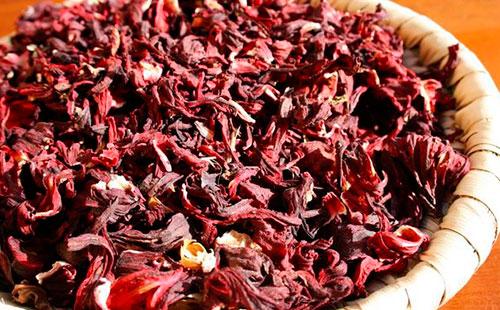
Pressure Effect
The experiment involved sixty-five volunteers aged thirty to seventy years. All of them suffered from varying degrees of hypertension. Participants were divided into groups, one of which took hibiscus tea three times a day, and the second received placebo tablets without an active substance.
Based on the study, American experts concluded that the undoubted benefit of hibiscus for the health of hypertensive patients is the ability to reduce high blood pressure. Moreover, the drink does this regardless of temperature. Therefore, the question of how to drink hibiscus under pressure is contrived. Use it as you like it.
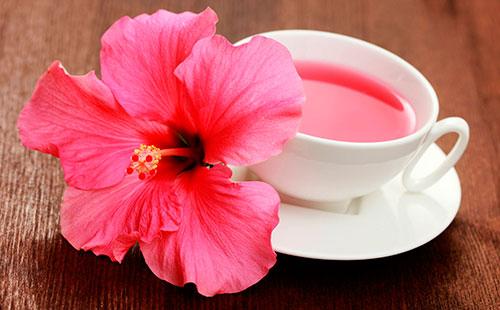
Recommendations for use
Sudanese rose is the least allergenic product, so it can be used in the diet of people prone to food allergies. Contrary to popular belief, its red color is due not to allergenic dyes, but to anthocyanins.
Hibiscus has no restrictions on "gender", as it does not in any way affect the hormonal background. The drink is equally beneficial and safe for men and women.
- For kids. There are no restrictions on the use of the drink in childhood. Offer it to toddlers and older kids in a warm form as an alternative to tea without invigorating caffeine.And in the cold instead of compote, as a source of ascorbic acid.
- During pregnancy. The opinion that a drink can harm the health of a future mother and baby is wrong. You can drink it in any trimester. But as with everything, moderation should be observed. Do not drink Sudanese tea in liters, limit yourself to a couple of cups of the drink throughout the day.
- With diabetes. “Hibiscus does not have a direct effect on blood sugar,” says endocrinologist Alexei Kolmakov. “But with diabetes, you should definitely use it as a source of antioxidants.” It is known that elevated sugar levels create the conditions for more aggressive “work” of free radicals. Hibiscus protects the body from their destructive effects, improves metabolic processes, has an antitoxic effect.
There is an opinion that the drink should not be consumed with gastritis, since it irritates the gastric mucosa. This opinion is erroneous, with gastritis hibiscus is not contraindicated, but it should be drunk only after eating, like other drinks containing acids (wine, juices).
The only condition of the body when harm to hibiscus is possible is a tendency to hypotension or low blood pressure. When drinking a drink, the pressure may decrease even more. But here we are talking about the systematic and regular use of it in the diet. If you never drink a cup of “red tea”, it will not bring any harm even with arterial hypotension.
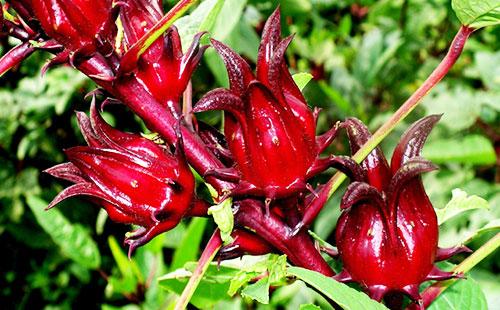
Making a drink
On sale you can find different varieties and types of Sudanese roses. It is sold in bulk bags weighing over a hundred grams and in small bags, packaged like regular tea. The choice is large, but not all types of hibiscus are equally useful.
The choice
When choosing a drink, be guided by the following principles.
- Large flowers. The larger the hibiscus flower, the more valuable substances he managed to accumulate. Choose a composition in which flowers are at least ten centimeters in diameter.
- Whole petals. The more broken leaves, the lower the quality of the raw material. It is reflected not only in the appearance of the "tea leaves", but also in its composition. Numerous creases indicate that the flowers have dried out, and the bulk of the valuable components have already been lost.
- Bright red color. A rich ruby hue of the petals indicates a high concentration of valuable anthocyanins. If the flowers are faded, the content of useful components in them is low.
- Only transparent packaging. Only through a transparent plastic bag can you evaluate the raw materials visually. Therefore, refuse to buy hibiscus in cardboard boxes.
- No sachets. Despite the fact that packaged forms of tea are convenient, hibiscus tea in this form should not be consumed. Milled into powder, it loses all its valuable qualities. Choose it only in the form of whole flowers.
Using the right quality raw materials, you can fully appreciate the beneficial properties of hibiscus. According to reviews, the taste sensations from a quality drink are many times brighter and more intense than from a packaged one.
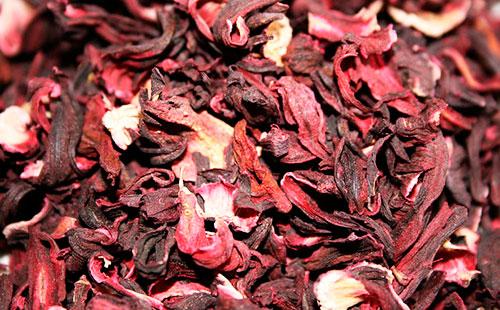
Storage
Anthocyanins are destroyed by direct sunlight, so it is important to avoid open areas during storage. Transfer the “tea leaves” from the original packaging into a glass or ceramic jar and tightly close it with a lid. Place in a dark place, such as a tea cabinet.
Under such conditions, the drink can be stored for three years, and its valuable properties will not change.

Tea Recipes
From high pressure, to invigorate and quench your thirst, to lose weight and to cleanse the body, drink a wonderful drink in the form in which you like it. We offer several recipes for its preparation.
- Classical. That is how the Egyptians prepared it. This method is still used today in the East. Soak the flowers at the rate of one teaspoon per cup in cold water and leave overnight. In the morning, simmer the infusion over low heat for five minutes. Drink it warm or chilled, add honey, sugar or ice to taste.
- Fast. Pour tea into a teapot at the rate of a teaspoon per person and one “bonus”. Pour boiling water and let it brew for ten minutes. The same petals can be poured with boiling water up to five times, but already from the third drink will be more transparent and less acidic. Hot hibiscus is tastier than cold.
- Healthy. Ascorbic acid is destroyed by boiling. To maintain the maximum benefit of the drink, fill the tea leaves with cold water and leave it under the lid for two days.
Upon boiling, the anthocyanins disintegrate, and the composition becomes "empty." The loss of healing qualities in a drink is evidenced by a change in its color from ruby to dirty gray. This broth is not worth drinking.
Useful properties of hibiscus are many times ahead of its contraindications. Bright and rich tea is rich in anthocyanins, has antioxidant, healing and anti-inflammatory properties. He is able to lower the pressure in any form, so with hypotension they should not get carried away. But in other cases, drink it without fear: it is suitable for children, pregnant women, the elderly.
